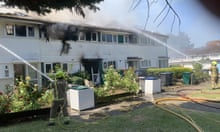Government safety experts last year warned that many tower blocks built from concrete panels that may pose a collapse risk have not been fixed, leaked documents reveal.
Minutes of the government’s structural stability working group revealed that experts warned Whitehall officials in 2022 that “buildings which were supposed to have undergone remedial work in previous decades have not been remediated”, and there were “consequential safety implications for such buildings”.
They also warned in December 2021: “Many structural defects are hidden from view,” and the “market is not responding in the way we would wish, prioritising profit over safety”.
The warnings emerged as hundreds of families were evacuated from Barton House, a 15-storey tower block in Bristol, over fears an explosion could pose “risk to the structure”, which is made from a large panel system (LPS).
Tenants and campaigners estimate there are about 575 LPS tower blocks still standing after construction mostly in the 1950s and 60s. Concern for their safety has simmered for decades after a gas explosion caused the partial collapse of Ronan Point in east London in 1968, killing four people.
When the panels are poorly assembled, gas blasts, fire or even strong winds can threaten their integrity.
Large panel systems were used widely in the postwar housing boom and there have been problems on many different council estates, leading to residents being moved out and buildings demolished.
In 2017 engineers were called to the Ledbury estate in Peckham, south-east London, to investigate 3cm-wide cracks between the panels that were opening and closing depending on the weather. Last year demolition and rebuilding was approved by Southwark council.
Residents in LPS blocks have been moved out in Portsmouth, where buildings were demolished in 2022, and in Rugby, where residents were moved out and blocks were demolished in 2021. Barton House in Bristol joined the list on Tuesday.
The minutes of the working group’s meetings reflect concern that the problem has not been grasped systematically. It warned that “many LPS buildings were not strengthened-post Ronan Point” and that “we were past the point of leaving this responsibility solely to the building owners”.
In particular, the committee heard in December 2021 that “the number, locations, conditions and presence of a gas supply [in LPS blocks] are not known, which is a cause for concern”.
In 2022 it called on the government to survey housing associations and councils to estimate the current numbers of buildings with LPS and also those built with reinforced autoclaved aerated concrete (RAAC) and to assign an estimated risk to each building.
A spokesperson for the Department for Levelling Up, Housing and Communities (DLUHC) said: “Following the Grenfell Tower tragedy [in 2017], the government has introduced some of the toughest building safety regulations in the world through its landmark Building Safety Act.
“The Act also introduced a new building safety regulator to assess the safety and standards of all buildings, to monitor and investigate any potential risks or changes that may affect residents’ safety and to oversee a culture of higher standards throughout our built environment.”
After the Grenfell fire, concerns have been growing inside Whitehall about LPS housing. Last December a senior civil servant made a formal submission to Lee Rowley, then the building safety minister, urging him to approve a nationwide programme to investigate the safety of ageing social housing blocks built with LPS concrete.
Frustrated that potential safety risks were not being properly addressed, the civil servant resigned citing the structural stability working group concerns that many LPS towers have not been strengthened.
In 2017, the government did tell social landlords “it is important with all large panel system buildings that their structural history is known, and that their condition and continued structural integrity are understood and monitored”.
Bristol city council said there was no record of any structural surveys of Barton House after remedial works were carried out around 1970.








